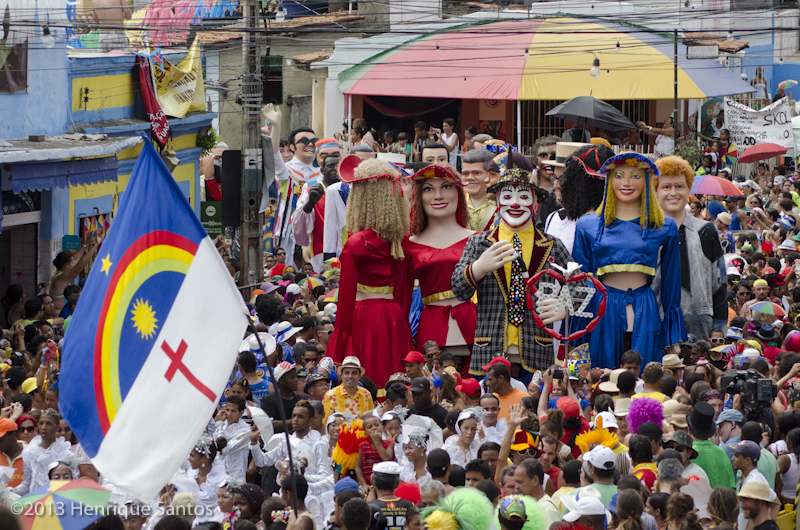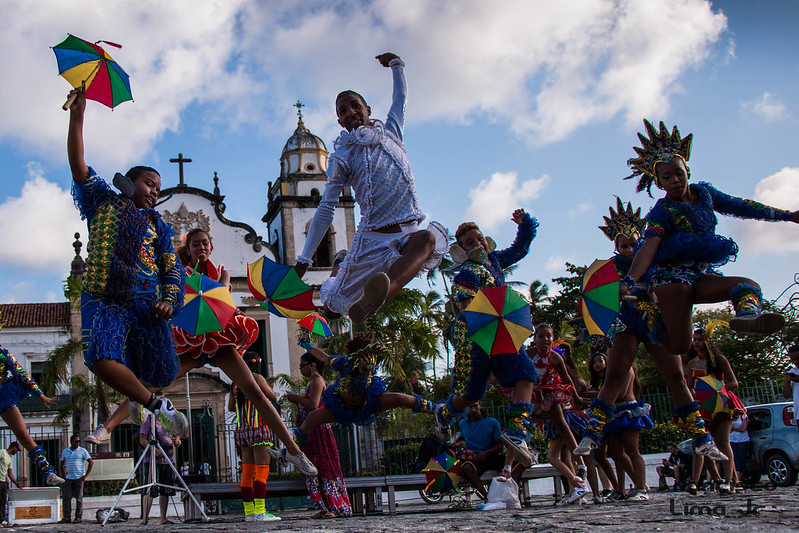Recife and Olinda Carnivals
A Living Kaleidoscope of Giant Puppets and Frevo
2026/02/12 - 2026/02/17
Every February, the neighboring cities of Recife and Olinda in northeastern Brazil burst into a grand carnival overflowing with music, dance, and color. Unlike any other carnival, here giant puppets (bonecos gigantes) parade above the crowds, and frevo dancers whirl at dizzying speed, sweeping both locals and visitors into a wave of joy. The scents of street food, the feel of cobblestones underfoot, and the rhythms of percussion and brass bands fill the streets, making this a festival that engages all five senses.
The festivities last nearly a week, peaking in the days just before Ash Wednesday. Recife’s “Galo da Madrugada” parade draws over two million participants, while Olinda’s steep hills become a stage for spontaneous parties, traditional maracatu, and countless blocos (street bands). For anyone seeking an authentic carnival experience, this is an unmissable event.
Main Attractions
Galo da Madrugada
The world’s largest carnival parade, “Galo da Madrugada” (“Rooster of the Dawn”), starts on Saturday morning in downtown Recife. Led by a giant rooster float, more than two million people march through the city with percussion groups, brass bands, and dancers. Frevo’s colorful umbrellas spin, confetti fills the air, and everyone dances and sings carnival songs with unstoppable energy.
Olinda’s Giant Puppets (Bonecos Gigantes)
Olinda’s carnival is famous for its giant papier-mâché puppets (bonecos gigantes), some over four meters tall. These puppets, modeled after celebrities, folklore characters, and local icons, parade down steep hills, thrilling both children and adults. The sensation of their swinging arms and vibrant costumes up close, and the surreal sight of looking up at these giants, is unforgettable.
Frevo and Maracatu
Frevo, a lightning-fast dance and musical style unique to Pernambuco, features dancers in colorful costumes and tiny umbrellas leaping to the rhythm of brass bands. Maracatu, rooted in Afro-Brazilian tradition, is characterized by powerful percussion, singing, and regal costumes reminiscent of African royalty. Both are central to the region’s identity and keep the streets alive day and night.
Key Events
Olinda’s churches host the moving “Noite dos Tambores Silenciosos” (“Night of the Silent Drums”), a ceremony honoring enslaved African ancestors. More than 500 blocos appear on street corners in Recife and Olinda, with children’s parades, costume contests, and spontaneous samba circles everywhere. Laughter, music, and the clinking of glasses echo through the warm, humid nights.
Costumes and Decorations
Participants wear everything from colorful wigs and capes to classic frevo outfits with ruffled skirts and umbrellas. Streets are draped with streamers, flags, and banners, and Olinda’s colonial houses are decorated with lanterns and murals. The textures of sequins, feathers, and face paint, and the scents of flowers and sweat, are all part of the festival.
Traditional Food & Drink
Street stalls offer tapioca crepes, bolo de rolo (guava roll cake), caldinho de feijão (bean soup), and grilled cheese skewers. Cold beer, caipirinhas, and sugarcane juice are favorites. The aromas of charcoal, tropical fruit, and spicy sauces fill the air and whet the appetite.
Cultural and Historical Background
The history of the Recife & Olinda Carnivals began in the 16th century during the Portuguese colonial era. At that time, the Portuguese brought the pre-Lenten festival known as “Entrudo” to Brazil. Entrudo was a riotous celebration involving water, perfume, and flour fights, turning the streets into a chaotic festive space. Over time, the music, dance, and rituals brought by enslaved Africans, along with Indigenous traditions, blended to create Pernambuco’s unique carnival culture.
From the late 19th to early 20th centuries, the carnival became more organized, with parades, costumes, and marching bands becoming the norm. Around this time, Olinda introduced its iconic giant papier-mâché puppets (bonecos gigantes), and in 1978, Recife launched the “Galo da Madrugada” parade. These have since become symbols of the carnival.
Frevo (brass band music and high-speed dance) and maracatu (Afro-Brazilian percussion, singing, and regal costumes) are unique performing arts that emerged from the fusion of African, Indigenous, and European cultures in Pernambuco. Frevo was inscribed on UNESCO’s Intangible Cultural Heritage list in 2012, and maracatu continues to be a source of regional pride.
Today, the Recife & Olinda Carnivals are among Brazil’s most celebrated cultural events, attracting millions of participants. Through music, dance, and rituals, they honor the region’s diverse roots and history. For locals, the carnival is a symbol of identity, pride, freedom, and solidarity—a special time that brings together people of all generations and backgrounds.
Participant Voices
Every year I look forward to Galo da Madrugada. Friends and strangers dance together for hours, and the feeling of unity in a shower of confetti is indescribable. It’s a day when the whole city feels like family. The music, costumes, and colors awaken all my senses. Marching in costume and beating the drums, I feel connected to an ancient power.
Fun Facts
- Galo da Madrugada holds the Guinness World Record as the world’s largest carnival parade, with over 2.5 million participants.
- Olinda’s giant puppets can be over 4 meters tall and weigh more than 20 kilograms.
Festival Dates
The Recife & Olinda Carnivals are held every February or March.
The event schedule is subject to change. Please check the official website for the most up-to-date information.
Information
| Name | Recife and Olinda Carnivals |
| Country | Brazil |
| Area | Recife and Olinda |
| Date | 2026/02/12 - 2026/02/17 |
| Link |
Upcoming Festivals
Dia de la Virgen de Guadalupe Mexico
A Festival Weaving Faith, Fervor, and Mexican Identity
2025/12/11L'Escalade Switzerland
Geneva’s Grand Winter Festival of Courage, Chocolate, and Community
2025/12/12Umkhosi Wokweshwama South Africa
The Zulu First Fruits Festival—A Sacred Celebration of Land, Ancestors, and Renewal
2025/12/12Lucia Festival (St. Lucia's Day) Sweden
A Festival of Light Illuminating the Nordic Darkness
2025/12/15Las Posadas Mexico
The Luminous Quest for Sacred Shelter
2025/12/22Noche de Rabanos (Night of the Radishes) Mexico
A celebration blending art, farming heritage, and cultural traditions
2025/12/23Chant of the Sybil on Majorca Spain
A Medieval Prophecy Echoes Through Majorcan Christmas
2025/12/23‘Hatajo de Negritos’ and the ‘Hatajo de Pallitas’ Peru
A Christmas Festival of Rhythm, Faith, and Afro-Andean Heritage in Peru’s Ica Region
2025/12/24Harbin International Ice and Snow Sculpture Festival China
A Frozen Wonderland Where Art and Adventure Merge
2025/12/24Takanakuy Peru
The Andean Festival of Reconciliation by Fist—How Confrontation Creates Year-End Peace and Bonds


